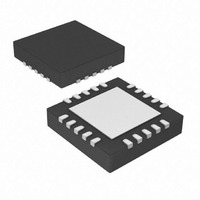PIC18F13K22-I/ML Microchip Technology, PIC18F13K22-I/ML Datasheet - Page 77

PIC18F13K22-I/ML
Manufacturer Part Number
PIC18F13K22-I/ML
Description
IC MCU 8BIT 8KB FLASH 20-QFN
Manufacturer
Microchip Technology
Series
PIC® XLP™ 18Fr
Datasheets
1.PIC18LF13K22-ISS.pdf
(388 pages)
2.PIC18LF13K22-ISS.pdf
(12 pages)
3.PIC18F13K22-ISS.pdf
(382 pages)
Specifications of PIC18F13K22-I/ML
Program Memory Type
FLASH
Program Memory Size
8KB (4K x 16)
Package / Case
20-VQFN Exposed Pad, 20-HVQFN, 20-SQFN, 20-DHVQFN
Core Processor
PIC
Core Size
8-Bit
Speed
64MHz
Connectivity
I²C, LIN, SPI, UART/USART
Peripherals
Brown-out Detect/Reset, POR, PWM, WDT
Number Of I /o
17
Eeprom Size
256 x 8
Ram Size
256 x 8
Voltage - Supply (vcc/vdd)
1.8 V ~ 5.5 V
Data Converters
A/D 12x10b
Oscillator Type
Internal
Operating Temperature
-40°C ~ 85°C
Processor Series
PIC18F
Core
PIC
Data Bus Width
8 bit
Data Ram Size
256 B
Interface Type
I2C, MSSP, SPI, USART
Maximum Clock Frequency
64 MHz
Number Of Programmable I/os
17
Number Of Timers
4
Operating Supply Voltage
1.8 V to 5.5 V
Maximum Operating Temperature
+ 125 C
Mounting Style
SMD/SMT
3rd Party Development Tools
52715-96, 52716-328, 52717-734, 52712-325, EWPIC18
Development Tools By Supplier
PG164130, DV164035, DV244005, DV164005
Minimum Operating Temperature
- 40 C
On-chip Adc
10 bit, 12 Channel
Lead Free Status / RoHS Status
Lead free / RoHS Compliant
Lead Free Status / RoHS Status
Lead free / RoHS Compliant, Lead free / RoHS Compliant
Available stocks
Company
Part Number
Manufacturer
Quantity
Price
Company:
Part Number:
PIC18F13K22-I/ML
Manufacturer:
SML
Quantity:
20 000
Part Number:
PIC18F13K22-I/ML
Manufacturer:
MICROCHIP/微芯
Quantity:
20 000
- Current page: 77 of 388
- Download datasheet (4Mb)
7.9
External interrupts on the RA0/INT0, RA1/INT1 and
RA2/INT2 pins are edge-triggered. If the corresponding
INTEDGx bit in the INTCON2 register is set (= 1), the
interrupt is triggered by a rising edge; if the bit is clear,
the trigger is on the falling edge. When a valid edge
appears on the RAx/INTx pin, the corresponding flag
bit, INTxF, is set. This interrupt can be disabled by
clearing the corresponding enable bit, INTxE. Flag bit,
INTxF, must be cleared by software in the Interrupt
Service Routine before re-enabling the interrupt.
All external interrupts (INT0, INT1 and INT2) can wake-
up the processor from Idle or Sleep modes if bit INTxE
was set prior to going into those modes. If the Global
Interrupt Enable bit, GIE, is set, the processor will
branch to the interrupt vector following wake-up.
Interrupt priority for INT1 and INT2 is determined by
the value contained in the interrupt priority bits,
INT1IP and INT2IP of the INTCON3 register. There is
no priority bit associated with INT0. It is always a high
priority interrupt source.
EXAMPLE 7-1:
2010 Microchip Technology Inc.
MOVWF
MOVFF
MOVFF
;
; USER ISR CODE
;
MOVFF
MOVF
MOVFF
INTx Pin Interrupts
W_TEMP
STATUS, STATUS_TEMP
BSR, BSR_TEMP
BSR_TEMP, BSR
W_TEMP, W
STATUS_TEMP, STATUS
SAVING STATUS, WREG AND BSR REGISTERS IN RAM
Preliminary
; W_TEMP is in virtual bank
; STATUS_TEMP located anywhere
; BSR_TMEP located anywhere
; Restore BSR
; Restore WREG
; Restore STATUS
PIC18F1XK22/LF1XK22
7.10
In 8-bit mode (which is the default), an overflow in the
TMR0 register (FFh 00h) will set flag bit, TMR0IF. In
16-bit mode, an overflow in the TMR0H:TMR0L regis-
ter pair (FFFFh 0000h) will set TMR0IF. The interrupt
can be enabled/disabled by setting/clearing enable bit,
TMR0IE of the INTCON register. Interrupt priority for
Timer0 is determined by the value contained in the
interrupt priority bit, TMR0IP of the INTCON2 register.
See Section 9.0 “Timer0 Module” for further details
on the Timer0 module.
7.11
An input change on PORTA or PORTB sets flag bit,
RABIF of the INTCON register. The interrupt can be
enabled/disabled by setting/clearing enable bit, RABIE
of the INTCON register. Pins must also be individually
enabled with the IOCA and IOCB register. Interrupt
priority for PORTA and PORTB interrupt-on-change is
determined by the value contained in the interrupt
priority bit, RABIP of the INTCON2 register.
7.12
During interrupts, the return PC address is saved on
the stack. Additionally, the WREG, STATUS and BSR
registers are saved on the fast return stack. If a fast
return from interrupt is not used (see Section 3.3
“Data Memory Organization”), the user may need to
save the WREG, STATUS and BSR registers on entry
to the Interrupt Service Routine. Depending on the
user’s application, other registers may also need to be
saved. Example 7-1 saves and restores the WREG,
STATUS and BSR registers during an Interrupt Service
Routine.
TMR0 Interrupt
PORTA and PORTB Interrupt-on-
Change
Context Saving During Interrupts
DS41365D-page 77
Related parts for PIC18F13K22-I/ML
Image
Part Number
Description
Manufacturer
Datasheet
Request
R

Part Number:
Description:
Manufacturer:
Microchip Technology Inc.
Datasheet:

Part Number:
Description:
Manufacturer:
Microchip Technology Inc.
Datasheet:

Part Number:
Description:
Manufacturer:
Microchip Technology Inc.
Datasheet:

Part Number:
Description:
Manufacturer:
Microchip Technology Inc.
Datasheet:

Part Number:
Description:
Manufacturer:
Microchip Technology Inc.
Datasheet:

Part Number:
Description:
Manufacturer:
Microchip Technology Inc.
Datasheet:

Part Number:
Description:
Manufacturer:
Microchip Technology Inc.
Datasheet:

Part Number:
Description:
Manufacturer:
Microchip Technology Inc.
Datasheet:











